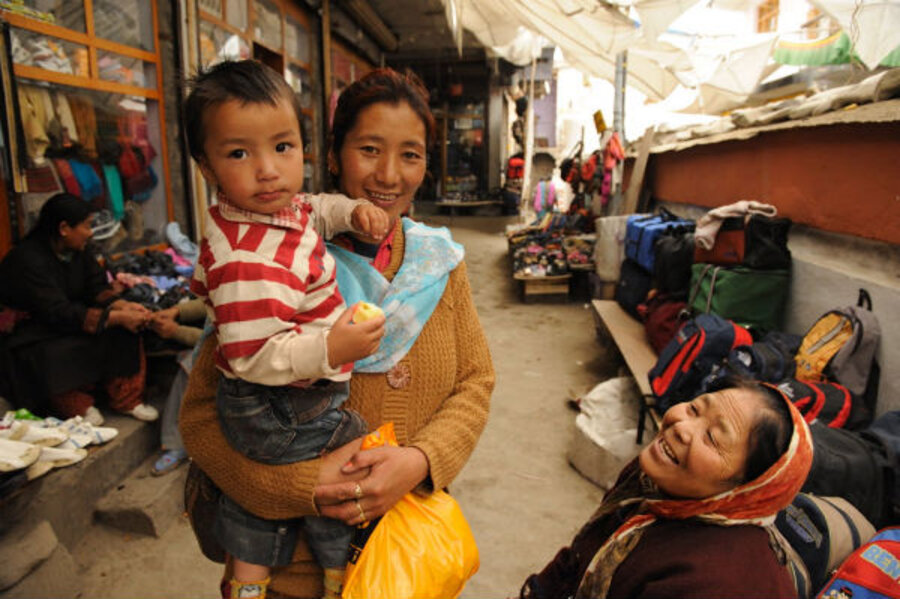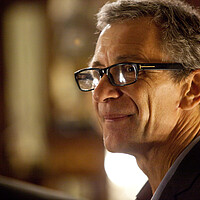Long journey to better education in India's Himalayas
Loading...
| Leh, India
The road marker says “Nerak 37 km,” only there is no more road – just a freshly bulldozed track that ends at a precipice. The real road is several hundred feet below: a snow-covered, snake-like strip of ice that cuts its way through an impossibly steep gorge.
This is the Zanskar River, a tributary of the mighty Indus in the Indian Himalayas. When it freezes in the winter, the locals call it “Chadar,” which in Hindi means veil or blanket. For three months of the year, ice transforms the river into the only route linking the remote district of Zanskar with the rest of India's Ladakh region.
The Chadar is a lifeline not just for traders and trekkers, but also for hundreds of children such as the 9-year old Tashi Lhamo. For her, making the arduous six-day journey from her remote snow-bound village in Zanskar is the only way to reach her boarding school in Leh, Ladakh’s capital, when classes resume in early March after the long winter break.
“No I wasn’t scared,” says Tashi, almost making it sound like just another adventure. “My father pulled me along in a sled.”
Her father, Padma Dorjay, tells a different story about their seasonal trek to school. An unseasonably warm week in February had started to melt the ice, he says, until the cold returned to make the river passable – but only just.
Mr. Dorjay, who hides his hunched back under a thick down jacket but can’t conceal a severe limp, described being knocked off his feet by a floating ice slab as he carried Tashi on his back through a melted section of the river.
He had to scramble up cliffs where rapids had broken through the surface. He spoke of 200 people sheltering in a huge cave waiting until the conditions were safe enough to proceed. It is not uncommon for army helicopters to rescue people when a part of the river melts, stranding them.
After the bulldozers reach Nerak, Zanskar’s 15,000 people may finally have year-round road access, though that could be years away. Until then, they must wait until May for the existing road to reopen after winter.
Breaking the cycle of poverty
So why do parents go to such lengths to bring their children to Leh? In a word, education.
“Parents have seen how their children’s lives can be transformed through a good education,” says Eshey Tundup, principal of the Lamdon Model Senior Secondary School. “They can stand on their own two feet, be independent.”
This independence is particularly critical in Ladakh, a region known as much for its stunning beauty as for its isolation and harsh climate. Compared to much of India, Ladakh is an education success story: There is not a single village without a school and the literacy rate is Leh is just over 80 percent – one of the highest in India.
But these raw statistics paint only part of the picture. In very remote areas, it is difficult to recruit qualified teachers. Poverty often drives children to work in the fields rather than attend class. And many poor nomadic families miss out on education altogether, though the government has experimented with mobile classrooms.
One secondary-school student who was also making the icy trek, 17-year-old Sonam Namgyal, describes his experience in one of the village schools. “My teacher was not a graduate, and there were 50 pupils in my classroom,” he says. “Sometimes I couldn’t attend because my father made me look after the animals.”
Sonam’s mother died when he was one year old. His father is a laborer who supplements his paltry wages by working in his fields and selling cow dung to neighboring villages. Getting to school meant a two-hour walk each way.
Since 2008, his education in Leh has been supported by an Australian charity, Lille Fro. Altogether, the charity is helping around 100 students to attend better schools, the majority of them in and around Leh.
Australian aid worker Tamara Cannon says the organization works closely with local government and village leaders to help supplement the traditional education model where it is not working effectively.
“Education… is such a basic human right for any child and has a powerful effect,” Ms. Cannon says. “Not only on the child, but also the family and village in terms of breaking that generational cycle of poverty.”
Education thriving
Strategically located near India's disputed borders with China and Pakistan, Ladakh benefits from the central government’s largesse. Its District Council enjoys a greater degree of autonomy than councils in other parts of India, and a booming tourism industry has brought jobs and a measure of prosperity.
Famed for its Buddhist monasteries and mountains, Ladakh's culture transcends religious differences. Leh, the regional capital, is dominated by a five-storey, mud-brick palace that would not look out of place in Lhasa. Young Ladakhi men saunter down the street in low-slung jeans and bomber jackets, sporting Bollywood hairstyles, mixing with Buddhist monks carrying prayer wheels and amulets. The region also has a large Muslim community.
“People say, ‘We are Ladakhis first – not Buddhists, not Muslims,’” explains Deen Khan, a local social activist. “Intermarriage is common, and there are no communal problems.”
And this cohesiveness has forged a solid foundation on which education can thrive, he says.
As the recess bell rings on the first day of term at the Druk Padma Karpo School, the playground erupts in a cacophony of laughter and shouting among children who are thrilled to see their friends after the long winter break.
Located 15 miles from Leh, the school is a private nonprofit. Of the 700 students here, roughly half rely on foreign charities such as Lille Fro to pay their tuition. Many come from remote parts of Ladakh that lack qualified teachers and fall short of meeting communities’ needs.
The school has won multiple awards for architectural excellence and environmental sustainability. Although it is around 5 degrees F. outside, the temperature in the south-facing classrooms is bearable.
School principal Prasad Eledath says that parents' expectations for their children's education is changing. “I feel hopeful now. There is a greater awareness of what kind of education a school should provide,” he says. “It’s not just about buildings and classrooms. It’s about the methodology being applied.”
Community roots
In addition to core subjects like English, Hindi, math, and social studies, pupils at Druk Padma Karpo study Bodhic – the local language of Ladakh – and creative arts such as drama and dance. “Education also happens in the community. It’s a different kind of knowledge but it’s a very valuable kind of knowledge," says Mr. Eledath.
Few people understand that better than Rani Sarla, the school’s administrator. She's also the titular head of the Ladakh royal family whose ancestors ruled over the Buddhist kingdom for three centuries before it was absorbed by India. “You need to go the village and talk to the headman. And only then can you find the really deserving children,” Ms. Sarla says. “Those who are very poor often don’t come forward. They accept that is their circumstance.”
The government is working to reach these children too. The "Nerak 37 km" marker is where a future road would link Zanskar district to Leh, although the extreme terrain means that it could be another decade before it opens.
For Cannon, that is too long to wait. This year her charity plans to break ground on a hostel in Padum, the district capital of Zanskar, so that children like Tashi and Sonam can attend school there rather than hiking down the icy Chadar to reach their boarding schools in Leh.
Punchok Tashi, the Executive Councillor for Zanskar district, welcomes the initiative. “Zanskar is cut off for six months of the year. That means no economic activity,” he says. “We can’t do anything about the climate, so education is our main priority. It is only the tool for overcoming ignorance and poverty.”
Editor's note: Names of children and their parents have been changed to protect the identities of Lille Fro’s beneficiaries.








